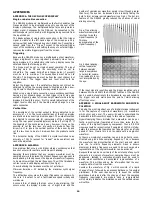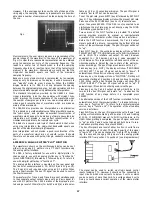
19
For
CH1
or
CH2
the secondary commands are as follows:
2mV, 5mV, 10mV, 20mV, 50mV, 100mV, 200mV, 500mV, 1V,
2V, 5V, or 10V (This sets the input sensitivity.)
AC, DC or GND (This sets the input coupling.)
ZERO or VAR,N (where N is a number between -100 and
+100) (This sets the offset level equal either to zero or to N%
of its maximum value.)
OFF or ON (This turns the channel off or on.)
Example: CH 1,20mV, DC,VAR,50 CR
For
TRG
the secondary commands are as follows:
CH1, CH2 or EXT (This sets the trigger source.)
AUTO, NORM or LINE (This sets the trigger mode.)
POS or NEG (This sets the trigger slope.)
ZERO or VAR,N (where N is a number between -100 and
+100) (This sets the trigger level either to zero or to ±N% of
its maximum value.)
AC, DC or HFREJ (This sets the trigger coupling.)
EDLY,N (where N is a number between 0 and 15) (This sets
the trigger events delay.)
TDLY,N (where N is a number between -40 and 9999) (This
sets the trigger time delay.)
Example: TRG,CH2,AC,TDLY, -10 CR
For
TMB
the secondary commands are as follows:
50nS, 100nS, 200nS, or 500nS (This sets the timebase speed
in nanoseconds per division).
or 1uS, 2uS, 5uS, 10uS, 20uS, 50uS, 100uS, 200uS, or 500uS
(this sets the timebase speed in microseconds per division).
or 1mS, 2mS, 5mS, 10mS, 20mS, 50mS, 100mS, 200mS, or
500mS (this sets the timebase speed in milliseconds per
division).
or 1S, 2S, 5S, 10S, 20S, 50S, 100S, 200S or 500S (This sets
the timebase speed in seconds per division).
or 10M, 20M, 50M, 100M or 200M (This sets the timebase
speed in minutes per division).
COMP (This sets the SEARCH function into Compress mode).
SCAN,N (where N is a decimal number between 0 and 3100)
(This sets the SEARCH function into Scan mode with the trace
starting at word N).
MAG,N (where N is a decimal number between 0 and 900)
(This sets the SEARCH function into Magnify mode with the
trace starting at word N).
SROFF (This turns any of the SEARCH modes off).
NORM, SLOW or FAST (This sets the display update rate).
ION or IOFF (This sets sine interpolation on or off).
AON or AOFF (This sets averaging on or off). Example:
TMB,10uS,AON,SLOW CR
For
TRA
or
TRB
the secondary commands are as follows:
HOME or VAR,N (where N is a number between -100 and
+100) (This sets the trace position either to "home" or to
N% of its maximum shift.)
CAL or UNCAL,N (where N is a number between 0 and 100)
CH1 or CH2 (This links the trace to CH1 (for TRA) or CH2
(for TRB).)
RCL,N (where N is a number between 1 and 16) (This
recalls a waveform to the display from the corresponding
indexed memory.)
SAVE,N (where N is a number between 1 and 16) (This
memory.)
SAVE,N 'where N is a number between 1 and 161 (This
stores the waveform presently displayed on the trace into
the corresponding indexed memory.)
ADD or NOADD (TRCA only) (This turns the "add B to A"
function on or off.)
INV or NOINV (TRCB only) (This turns the trace invert func-
tion on or off.)
Example: TRA,HOME,UNCAL,40 CR KEY
KEY
The KEY command enables the front panel of the DSA to be
controlled in exactly the same manner as if the front panel keys
were being pressed. This command provides for control of any
key operated function including those not covered by the pre-
vious six primary commands (e.g. PLOT).
The primary command, KEY, must be followed by one or more
(maximum five) secondary commands each of which represents
a front panel key. Each secondary command is a two or three
digit decimal code as shown on the diagram below.
Example: KEY,34,34,97 CR
This would have the effect of incrementing the CH1 volts/div by
two steps and decrementing the timebase time/div by one step.





































